Height African civet: 40 cm | Scientific name Viverridae Higher classification Feliformia | |
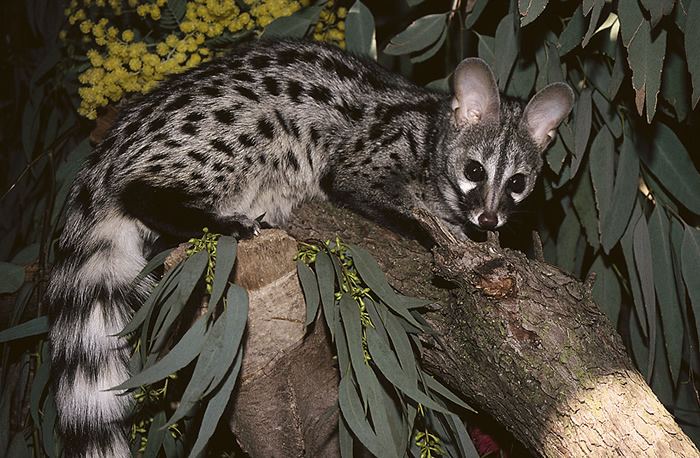 | ||
Lifespan African civet: 15 – 20 years, African linsang: 5 years Lower classifications | ||
Viverridae is a family of small to medium-sized mammals, the viverrids (/vaɪˈvɛrɪDz/), comprising 15 Genera, which are subdivided into 38 species. This family was named and first described by John Edward Gray in 1821. Members of this family are commonly called civets or genets. Viverrids are found in South and Southeast Asia, across the Wallace Line, all over Africa, and into southern Europe. Their occurrence in Sulawesi and in some of the adjoining islands shows them to be ancient inhabitants of the Old World tropics.
Contents
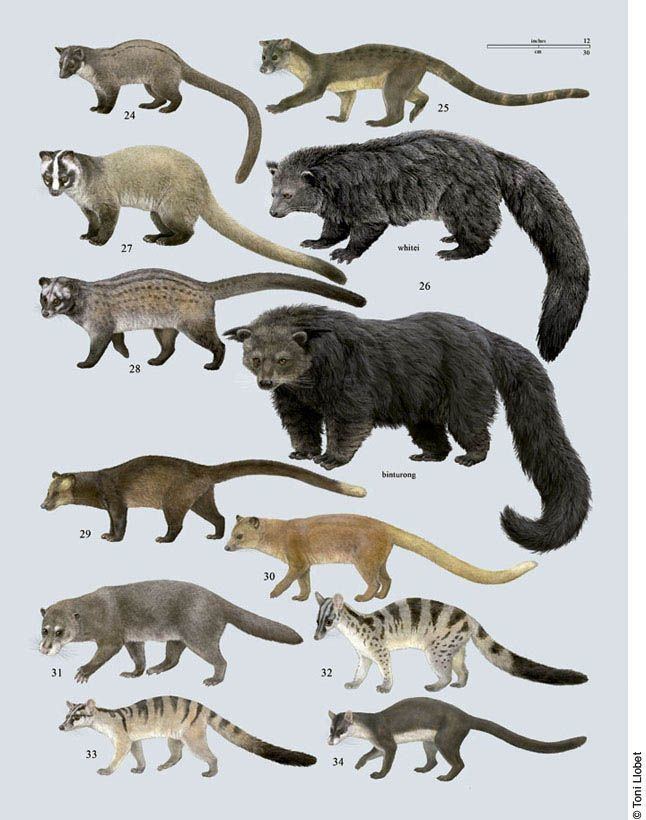
Characteristics
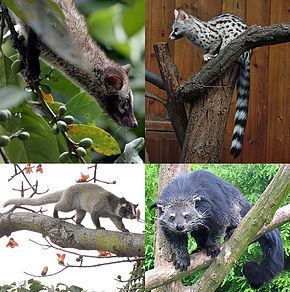
Viverrids have four or five toes on each foot and half-retractile claws. They have six cutting teeth in each jaw and true grinders with two tubercular grinders behind in the upper jaw, and one in the lower jaw. The tongue is rough with sharp prickles. A pouch or gland occurs beneath the anus, but there is no coecum.
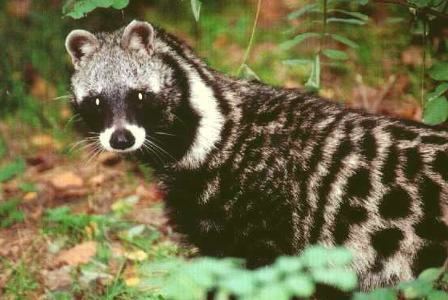
Viverrids are the most primitive of all the families of feliform Carnivora and clearly less specialized than the Felidae (cats). In external characters, they are distinguished from the Felidae by the hind foot being five-toed owing to the invariable presence of the first digit, by the retention of the interramal tuft of facial vibrissae, and typically by the longer muzzle and shorter limbs. The skull differs by the position of the postpalatine foramina on the maxilla, almost always well in advance of the maxillopalatine suture, and usually about the level of the second premolar; and by the distinct external division of the auditory bulla into its two elements either by a definite groove or, when rarely this is obliterated, by the depression of the tympanic bone in front of the swollen entotympanic. The typical dental formula is: 3.1.4.23.1.4.2, but the number may be reduced, although never to the same extent as in the Felidae.
Their flesh-shearing carnassial teeth are relatively undeveloped.
Most viverrid species have a baculum.
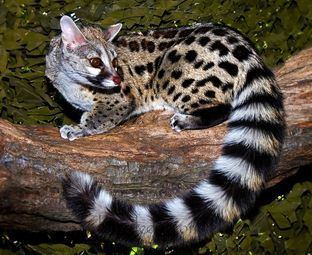
Viverrids range in size from the African linsang with a body length of 33 cm (13 in) and a weight of 650 g (1.43 lb) to the African civet at 84 cm (33 in) and 18 kg (40 lb), although very large binturongs, which can weigh up to 25 kg (55 lb), attain the greatest mass.
Ecology and behavior
They are generally solitary and have excellent hearing and vision. They are omnivorous, or, in the case of the palm civet, almost entirely herbivorous.
Favored habitats include woodland, savanna, mountains, and above all, tropical rainforest. Due to heavy deforestation, many are faced with severe loss of habitat; several species are considered vulnerable such as the rare Hose'S palm civet, which is endemic to northern Borneo; the Otter civet is classified as endangered.
Classification
In 1821, Gray defined this family as consisting of the genera Viverra, Genetta, Herpestes, and Suricata. Reginald Innes Pocock later redefined the family as containing a great number of highly diversified genera, and being susceptible of division into several subfamilies, based mainly on the structure of the feet and of some highly specialized scent glands, derived from the skin, which are present in most of the species and are situated in the region of the external generative organs. He subordinated the subfamilies Hemigalinae, Paradoxurinae, Prionodontinae, and Viverrinae to the Viverridae.
The Viverridae consist of:
Some authorities are of the opinion that the subfamily Prionodontinae, which consists of two extant species of Asiatic linsangs in the genus Prionodon, should be regarded as a family in its own right.
In 1833, Edward Turner Bennett described the Malagasy fossa (Cryptoprocta ferox) and subordinated the Cryptoprocta to the Viverridae. A molecular and morphological analysis based on DNA/DNA hybridization experiments suggests that Cryptoprocta does not belong within Viverridae, but is a member of the Eupleridae.
The African palm civet (Nandinia binotata) resembles the civets of the Viverridae, but is genetically distinct and belongs in its own monotypic family, the Nandiniidae. There is little dispute that the Poiana species are viverrids.
Phylogeny
The following cladogram shows the phylogenetic relationships for the revised Viverridae, based on the molecular genetics study of Gaubert & Cordeiro-Estrela (2006), with additional species placed according to the supertree study of Nyakatura & Bininda-Emonds (2012).
